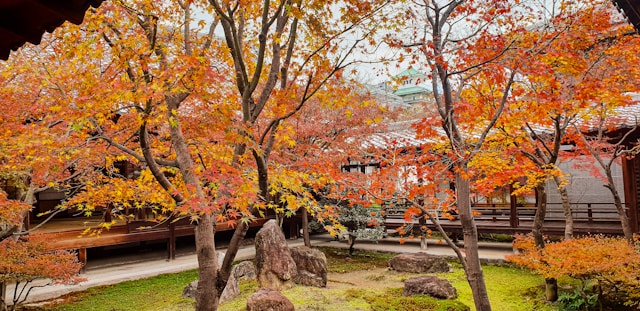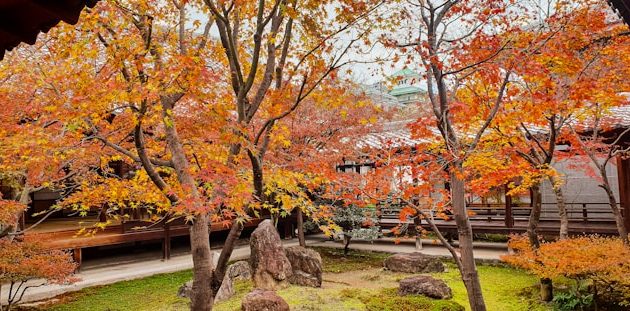
Kyoto, the ancient capital of Japan, is a city that captivates visitors throughout the year, offering distinct seasonal experiences that reflect the natural beauty and cultural heritage of Japan. From the iconic cherry blossoms of spring to the fiery hues of autumn leaves, each season brings a unique charm to Kyoto’s temples, gardens, and historical sites. In this article, we will explore the wonders of Kyoto’s seasons, focusing on the highlights of each time of year, including cherry blossoms, autumn leaves, and the quieter yet equally enchanting summer and winter.
Spring in Kyoto: The Magic of Cherry Blossoms
Spring in Kyoto is synonymous with sakura, or cherry blossoms. This fleeting season, which typically begins in late March and lasts until mid-April, transforms the city into a pink paradise, attracting visitors from around the globe. The gentle pink and white blossoms blanket Kyoto’s parks, temples, and riversides, creating postcard-perfect scenes at every turn.
Best Spots for Cherry Blossom Viewing
Kyoto offers countless locations to enjoy the cherry blossoms, but a few stand out as must-visit spots:
- Maruyama Park: One of the most popular cherry blossom viewing spots in Kyoto, Maruyama Park is home to a massive weeping cherry tree, which becomes the focal point for hanami (flower viewing) parties. The park is illuminated at night during the sakura season, allowing visitors to enjoy the blossoms in a magical, romantic atmosphere.
- Philosopher’s Path: This picturesque canal-side walk, lined with hundreds of cherry trees, stretches between Ginkaku-ji (Silver Pavilion) and Nanzen-ji Temple. As you stroll along the path, you’ll be surrounded by falling petals, offering a peaceful and immersive cherry blossom experience.
- Kiyomizu-dera Temple: One of Kyoto’s most famous temples, Kiyomizu-dera offers stunning panoramic views of the city, particularly during the cherry blossom season. The temple’s wooden stage is the perfect vantage point for admiring the sea of sakura trees below.
Cultural Significance of Sakura
In Japan, the cherry blossom season is more than just a beautiful natural event; it holds deep cultural significance. Sakura represents the transient nature of life, with the brief blooming period reminding people of the impermanence and beauty of existence. During this time, locals and tourists alike participate in hanami (flower-viewing) parties, gathering under the trees to celebrate the arrival of spring and enjoy food, drink, and the company of loved ones.
Autumn in Kyoto: A Symphony of Colors

As summer fades, Kyoto undergoes another breathtaking transformation. From late October to early December, the city becomes a vibrant tapestry of red, orange, and gold as the autumn leaves (koyo) reach their peak. Kyoto’s temples, shrines, and gardens are particularly stunning during this season, making autumn one of the best times to visit the city.
Top Places to See Autumn Leaves in Kyoto
- Arashiyama: This scenic area on the outskirts of Kyoto is famous for its bamboo grove, but in autumn, it’s the fiery red and orange leaves that steal the show. Take a boat ride down the Hozu River or hike through the surrounding mountains for a front-row seat to the autumn spectacle.
- Tofuku-ji Temple: Known for its expansive gardens and traditional architecture, Tofuku-ji is one of the best places in Kyoto to view the autumn leaves. The temple’s Tsutenkyo Bridge offers an incredible vantage point for taking in the vibrant colors of the maple trees below.
- Eikando Temple: Another top spot for koyo viewing, Eikando Temple is famous for its beautiful gardens and the way its autumn leaves reflect in the temple’s ponds. In the evening, the grounds are illuminated, creating a mesmerizing display of color and light.
The Cultural Importance of Autumn in Japan
In Japanese culture, autumn is associated with momijigari, or “autumn leaf hunting,” which refers to the practice of seeking out the best places to view the changing leaves. Like cherry blossom viewing, momijigari is a time for reflection and appreciation of nature’s beauty. Autumn is also a time for festivals and traditional events in Kyoto, such as the Jidai Matsuri (Festival of the Ages), where participants dress in historical costumes and parade through the city, celebrating Kyoto’s rich cultural history.
Summer in Kyoto: Tranquil Gardens and Festivals
While summer in Kyoto can be hot and humid, it is still a season worth experiencing. The lush greenery of the city’s gardens and the lively festivals provide a refreshing contrast to the more famous spring and autumn seasons.
Kyoto’s Summer Gardens
Kyoto’s gardens are a tranquil escape from the heat, with shady trees, flowing streams, and vibrant moss-covered landscapes. Some of the best gardens to visit during summer include:
- Saiho-ji (Kokedera): Also known as the Moss Temple, Saiho-ji is renowned for its over 120 varieties of moss, which thrive in the humid summer months. The soft, green carpet of moss gives the garden an otherworldly feel, making it a peaceful retreat from the bustling city.
- Katsura Imperial Villa: This sprawling garden features perfectly manicured landscapes, traditional tea houses, and a serene pond. The villa’s design emphasizes harmony with nature, and its gardens are particularly beautiful during the summer months.
Kyoto’s Summer Festivals
Summer in Kyoto is also a time for lively festivals that bring the city’s streets to life. The Gion Matsuri, held in July, is one of Japan’s most famous festivals and features massive, elaborately decorated floats parading through Kyoto’s downtown area. The festival has been held for over a thousand years and is a vibrant celebration of Kyoto’s history and traditions.
Winter in Kyoto: Serene Snow-Covered Temples
Winter in Kyoto may not be as popular as the other seasons, but it offers a quiet, serene beauty that is hard to find during the busier times of the year. Snow-covered temples and gardens create a peaceful and reflective atmosphere, making it the perfect time for those looking to experience a more contemplative side of the city.
Best Winter Experiences in Kyoto
- Kinkaku-ji (Golden Pavilion): The Golden Pavilion covered in snow is a sight to behold. The contrast between the gold-leaf exterior of the temple and the pure white snow creates an image of timeless beauty. This is one of the most iconic winter scenes in Kyoto and should not be missed.
- Ryoan-ji Temple: Known for its famous rock garden, Ryoan-ji takes on a different character in winter. The simplicity of the snow-covered rocks and raked gravel creates a tranquil setting, perfect for quiet reflection.
- Kurama Onsen: Located in the mountains just outside of Kyoto, Kurama Onsen is an ideal place to warm up after a day of sightseeing. Soak in the outdoor hot springs while enjoying views of the snow-covered landscape.
The Quiet Charm of Winter
Winter in Kyoto is a time of quiet reflection and solitude. With fewer tourists around, you can explore the city’s temples and gardens at a leisurely pace, without the crowds that accompany the spring and autumn seasons. Winter also brings its own set of seasonal dishes, such as nabe (hot pot), which is perfect for warming up after a day spent in the cold.
Conclusion
Kyoto is a city of unparalleled beauty, with each season offering its own unique appeal. Whether you’re visiting during the cherry blossom season in spring, the vibrant autumn leaves, or the quieter summer and winter months, Kyoto promises a rich and unforgettable experience. The city’s blend of natural beauty, historical significance, and cultural heritage makes it one of Japan’s most captivating destinations, no matter the time of year.